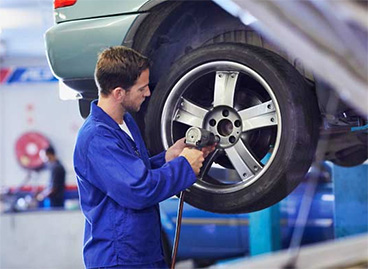Proper tire maintenance is crucial for ensuring a long lifespan, optimal performance, and safety. Here are some tips to help you maintain your tires:
-
Regular Inspections:
- Conduct visual inspections of your tires regularly. Look for signs of damage, such as cuts, bulges, or uneven wear. If you notice any issues, have them inspected by a professional.
-
Proper Tire Pressure:
- Maintain the recommended tire pressure as specified by your vehicle manufacturer. Underinflated or overinflated tires can lead to uneven wear, reduced fuel efficiency, and compromised safety. Check tire pressure at least once a month and before long trips.
-
Tire Rotation:
- Rotate your tires regularly to ensure even wear. Front and rear tires can wear differently due to factors like weight distribution and steering. Follow the recommended rotation pattern in your vehicle’s owner’s manual, typically every 6,000 to 8,000 miles.
-
Wheel Alignment:
- Get your wheels aligned if you notice uneven or rapid tire wear, or if your vehicle pulls to one side. Proper wheel alignment ensures that your tires wear evenly and that your vehicle drives straight.
-
Balancing:
- Balancing your tires helps distribute the weight evenly, preventing uneven wear and improving ride comfort. Have your tires balanced whenever you install new tires, or if you experience vibrations while driving.
-
Avoid Overloading:
- Do not exceed the load-carrying capacity of your tires. Check your vehicle’s load capacity in the owner’s manual and adhere to weight limits.
-
Proper Driving Habits:
- Avoid aggressive driving, sharp turns, and sudden stops. These actions can contribute to uneven tire wear and reduce tire lifespan.
-
Storage:
- If you have a spare set of tires for seasonal use, store them in a cool, dry place away from direct sunlight. Consider using tire covers to protect them.
-
Clean Tires Regularly:
- Clean your tires regularly to remove dirt, grime, and brake dust. Use mild soap and water, and avoid harsh chemicals that can damage the rubber.
-
Tire Age:
- Tires have a limited lifespan, even if they have sufficient tread depth. If your tires are more than six years old, consider having them inspected regularly, as aging can affect tire integrity.
Remember to follow the specific recommendations provided by your tire manufacturer and vehicle owner’s manual. If you have any concerns about your tires, consult with a professional tire technician or mechanic for advice. Regular maintenance and timely interventions can contribute significantly to extending the lifespan of your tires.
